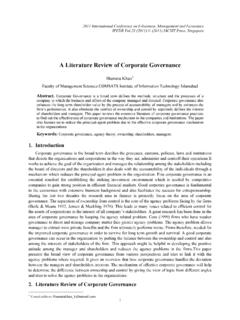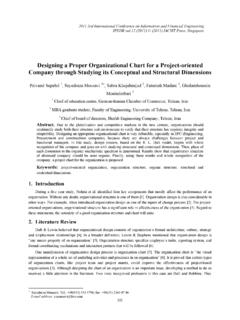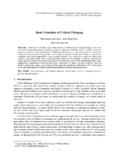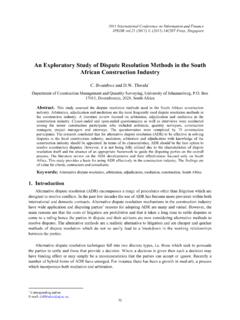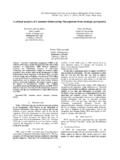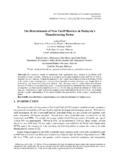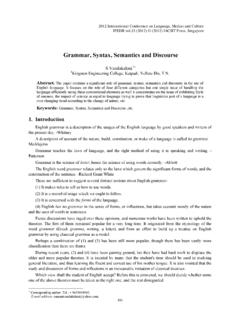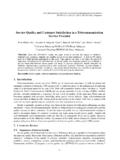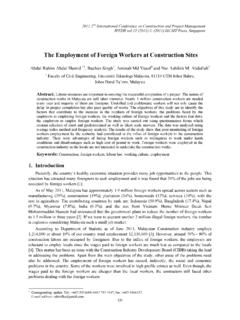Transcription of Tabung Haji as an Islamic Financial Institution for ...
1 Tabung haji as an Islamic Financial Institution for Sustainable Economic Development Mohd Shuhaimi Bin haji Ishak1 Abstract. Tabung haji (TH) is a short synonym for Lembaga Urusan dan Tabung haji Malaysia (The Pilgrims Management and Fund Board of Malaysia) started its operation in 1963 to assist the Muslim/rural community in Malaysia with the Financial costs of performing the hajj to Saudi Arabia. TH acts as an Institution of savings for Muslims to fulfill their religious obligation. This research attempts to highlight TH as a role model of an Islamic Financial Institution for economic development. The research aims to show the significance of TH by analysing its business activities and their Financial performances to illustrate that it is a viable business entity for sustainable economic development. Keywords: TH, Pilgrimage, Islamic Financial Institution , Depositors and Sustainable Economic Development 1.
2 Introduction Traditionally, the method of savings for the Muslim/rural community consisted of putting their savings under the pillow, mattress and floor, cupboards, or earthen jars which were buried for safety. Some also purchased of land or livestock and later resold to meet the expenses on the journey to the Holy Rural Muslims in Malaysia had resorted to these means of savings due to the strong desire to be absolute sure that the money for the purpose of pilgrimage will be considered clean or not tainted with usury or riba that was inherent in modern banking. Based on his sincere desire and aspiration to overcome poverty among Muslims in rural and remote areas, Royal Professor Ungku Aziz made several researches in 1950s. Prof. Ungku Aziz also made some researches and inquiries on the aspect of riba in Islam by seeking the expert opinions of a few learned Islamic scholars. From his thorough investigations on the question of poverty and savings for pilgrimage, Ungku Aziz prepared a working paper entitled Pilgrims Economy Improvement Plan to the Government of Malaysia in Ungku Aziz came to the conclusion that the proposal was aimed to help the prospective pilgrims to perform pilgrimage and at the same time mobilised the funds for economic development of the nation.
3 He insisted that the plan would enable the poor who did not have the means to make large savings have an opportunity to save over long period of time and thus avoiding the traditional method of savings. Moreover, he also thought that through such scheme the fund can be utilised to ensure proper management of pilgrimage while offering services to pilgrims while in Saudi Arabia. 2. History and Development of TH TH was incorporated in 1962, is a manifestation of the Malaysian government concern over the welfares of the Muslim populace in relation to their pilgrimage to the Holy Land. The fundamental concept behind the 1 Assistant Professor of International Islamic University Malaysia, Tel. No: 012-2609978; Fax No. 03-61965504; Email: 2 Mohd. Saleh Bin Awang, haji di-Semenanjung Malaysia: Sejarah dan Perkembangannya Sejak Tahun 1896-1985 (Hajj in Peninsula Malaysia: History and Development Since 1896-1985), (Kuala Trengganu: Syarikat Percetakan Yayasan Islam Trengganu Sdn.)
4 , 1986), p. 255. 3 Malaysia, Prime Minister Department, Sejarah Perkembangan Tabung haji Malaysia 30 Tahun (Historical Development of Tabung haji Malaysia over 30 years), (Kuala Lumpur: Utusan Printcorp Sdn. Bhd., 1993), p. 71. 236 2011 2nd International Conference on Humanities, Historical and Social Sciences IPEDR (2011) (2011)IACSIT Press, Singapore incorporation was to enable Muslims to save for pilgrimage without fear of the money being tainted by Basically, TH has a two-pronged strategy. It aims to rectify the social-economic problems of the Muslims while at the same time allows them to invest and effectively participate in the nation s economic development. Broadly speaking, TH has the following goals:5 To enable Muslims to save gradually in order to provide for their expenses in performing the pilgrimage or for other expenses beneficial to them; To enable Muslims through their savings to participate in investments in industry, commerce and plantations as well as real estates, according to Islamic principles; and To provide for protection, control and welfare of Muslims while on pilgrimage through various facilities and services of TH.
5 As the number of pilgrims increases every year, TH continues to strive to enhance its facilities and services. Since its inception, the regular facilities and services for the pilgrims include saving deposits, transportations and visa, information and guidance on pilgrimage and religious rituals, accommodation, medical services and health care. In 1970s, the ratio of pilgrims to a medical doctor was 1,600:1 but the ratio had improved to 1,000:1 towards Now, TH has extended its facilities and services to include its own hospital and medical centers in Mecca and Medina, a field hospital in Arafah/Mina with adequate medical personnel on duty round the clock. From a modest start with 1,281 depositors in 1063 and a total deposit of US$15,400 through its three branch offices, TH has now grown into a big corporate From a humble beginning pioneered by 13 staff and began by managing 5,000 pilgrims travelling by ships in Today, TH manages efficiently some 26,000 pilgrims travelling by air departing from five airports.
6 As at the end of the year 2009, TH has more 5 million depositors, the deposit-taking offices are expanded to more than 345 locations all over Malaysia and a total deposit of US8 From an initial government grant of RM152,000-00 (US$50,000-00) in 1963, now TH s total deposit is about US9 billion. Since its incorporation, TH is actively involved in a variety of economic activities namely- commercial, industrial, housing development and plantations. 3. Functions and Services of TH TH basically undertakes a broad scope of functions. Primarily, it collects savings throughout Peninsula Malaysia, Sabah and Sarawak in 345 locations. TH also made special banking arrangements with Pos National Berhad (Malaysia s Postal Service) and two commercial banks for the collection of deposits. To offer better and convenient services, TH allows the deduction of salary of employees from both public and private sectors.
7 Recently, TH has further enhance its services by collaborating with Bank Islam Malaysia Berhad and Bank Rakyat Malaysia Berhad for deposit, transfer and withdrawal services and also the use of ATM cards issued by them. Additionally, TH also performs both religious and social services to the pilgrims. TH manages pilgrimage affairs in matters pertaining to conduct of courses on pilgrimage, arrangement of medical services, issue of hajj visa, arrangement of transportation and provision of welfare and medical services to pilgrims both in Malaysia and Saudi Arabia. Professionally, TH undertakes to make investment of depositors savings in accordance to investment principles and tenets of Islam. In addition to the above services, TH greatly improved the pilgrims preparation for their pilgrimage. Since 1963, a course for Bakal haji (Prospective Hajj) was initiated and offered in each district beginning 4 Islamic Development Bank, Proceedings of the Workshop on the Organization and Management of the Pilgrims Management and Fund Board of Malaysia, (Jeddah: Islamic Research and Training Institute, 1987), p.
8 1. 5 Mohd. Saleh Bin Awang, , p. 256. 6 Prime Minister Department, Malaysia, , pp. 135-146. 7 Islamic Development Bank, , p. 1. 8 Lembaga Urusan dan Tabung haji s Annual Report for 2007, p. i. 9 Lembaga Urusan dan Tabung haji s Annual Report for 2009, pp. 5-6. 237six months before the hajj season. Today, these courses consists 13-15 lecture series, demonstrations, films designed to clarify both theory and practice relating to the hajj rites and rituals. TH constantly reminds pilgrims to instill calm and patience throughout their stay in Saudi Arabia as sometimes they often beset by problems and difficulties. It stresses its pilgrims the philosophy of hajj so as to enable them to perform their religious duties sincerely and wholeheartedly to God. In other words, a complete set of formal training covering the rituals to personal health awareness are part of TH s service to its depositors. 4. Business and Investment of TH The accumulated fund from the depositors is invested into various businesses and investments in order to generate and maximize returns.
9 TH ensures that the Financial investments are according to the principles of Islamic tenets. From the latest TH s Annual Report ending 2009, these Financial investments are in businesses involving plantation, Islamic banking, construction, real estate, information technology, and services sectors. At the same time TH prudently invest in equity, Initial Public Offer (IPO), IDB Islamic Infrastructure Fund, private equity fund and security deposits. In the plantation sector, TH and its Group of companies own a massive 200,000 hectares of land in Malaysia and Indonesia for palm oil plantations. These plantations are managed by THP Agro Management Sdn. Bhd., 100% owned by TH and employs 580,000 workers. TH and Group also have 12 factories in Malaysia and Indonesia that are able to process palm oil fruits of between 10 to 120 metric ton per hour. In the Islamic banking and insurance sector, TH is a major shareholder of Bank Islam Malaysia Berhad (BIMB) and Syarikat Takaful Malaysia Berhad (TM), which is holds a majority stake of 51% and respectively.
10 BIMB now has 101 branches all over Malaysia. As at Financial end 2008, it recorded a revenue of US 341 million with a profit of US $ million after tax and zakat TM recorded US $ million in operating revenue and a profit of US $ million after tax and Both BIMB and TM are listed on the Bursa Malaysia, which is one of the largest bourses in Asia. TH s involvement in the construction sector is via TH Technologies Sdn. Bhd. (THT), a fully owned subsidiary company. THT is currently undertakes two major projects namely, the construction of Police Station and Quarters worth US $ million in Subang Jaya, Selangor and the construction of a 34-storey commercial complex of a waqf land worth US $ million in Jalan Perak, Kuala For the year ending 2009, THT had secured two major projects namely, the construction of Police Camp worth US $ million over acres in Bidor, Perak and the construction Training Institute of Statistic Malaysia worth US $ million over acres in Sungkai, THT is now embarking into the ship building construction with the task of building two ships under the category of Anchor Handling Tug Supply, with the maximum speed of thousand horse power.
